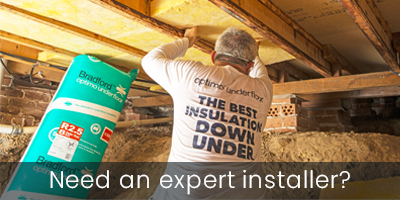
Like a blanket under your floor
For suspended timber floors, Optimo is the perfect solution to keep your home and your family snug all year round
Install Optimo in a weekend
Step by step tips, pack calculator and selection guide available
Building a new home? Doing an extension?
Bradford Optimo Saddles are designed to hold underfloor insulation in place in new build installation.

Like a blanket under your floor
For suspended timber floors, Optimo is the perfect solution to keep your home and your family snug all year round
Install Optimo in a weekend
Step by step tips, pack calculator and selection guide available
Building a new home? Doing an extension?
Bradford Optimo Saddles are designed to hold underfloor insulation in place in new build installation.
Optimo Underfloor Insulation - Flooring Insulation
Bradford Optimo™ is the ultimate in underfloor insulation for suspended timber floors, keeping homes warmer and reducing energy costs through winter.
Most Australian homes have ceiling insulation and new homes now also include wall insulation which is installed at the time of construction. However, for homes with suspended floors, it is one element of the envelope that may not be insulated and this can contribute to as much as 20% of heat loss in winter. Bradford's Optimo Underfloor insulation is the solution, allowing you to address this neglected area and maximise your home's comfort and energy efficiency.
A polished timber floor looks warm and inviting – but looks can be deceiving. Without insulation, your flooring material is the only thing between you and the elements. Heat can be lost and draughts can enter through the floorboards making your home cold and uncomfortable. Bradford Optimo provides a barrier to reduce heat loss and cold draughts entering through gaps in the flooring.
Optimo underfloor insulation will provide a barrier to reduce heat loss and cold draughts entering through gaps in the flooring keeping the homes more comfortable and energy efficient.
See more on The Block.
- Benefits
- Installing Optimo
- Where to buy
- Best acoustic performance in Australia
- Read our reviews
- Choosing Optimo
- How many packs will I need?
- Optimo accessories
- Healthy Homes' Installation video
-
FAQs
These are some of the common questions asked about underfloor insulation. If your question is not answered here, please get in touch with us.
-
What is underfloor insulation?
Underfloor insulation is applied to suspended timber floors in residential homes. Many homes with ceiling and wall insulation do not have their suspended timber floors insulated and these can contribute to significant heat loss in winter.
Optimo is installed under a suspended floor using straps if it is an existing home or saddles if it is a new build. It is considered the last barrier of defence between you and the cold outside air. -
How does it work?
Bradford Optimo works like a blanket installed under your suspended floor; it inhibits heat loss which allows heaters to be used more efficiently. Optimo also helps to stop draughts entering through gaps in the flooring.
With an R-Value of R2.5, Bradford Optimo boasts one of the highest levels of thermal performance on the market to help keep you cosy during winter and keep energy bills down. -
What is R-Value?
R-values rate the level of thermal resistance or the performance of insulation materials. Essentially, the higher the R-Value the more effective the insulation is. Bradford Optimo underfloor insulation is available in R-Value R2.5.
-
What is it made from?
Optimo is manufactured from glasswool – the most popular home insulation product in the world. The batts are specially stiffened and treated to provide a moisture resistant underfloor insulation.
The glasswool is made from around 65% recycled glass which is melted and then spun like fairy floss to create millions of air pockets. These air pockets are very poor conductors of heat, providing a cost-effective insulation. -
Is Optimo safe for my family?
Bradford Optimo is made from inert raw materials that resist fire and pose no health risk to you or your family. Bradford is the only approved insulation partner of the National Asthma Council Australia Sensitive Choice program.
Bradford Optimo is suitable for use in the homes of asthma and allergy sufferers. Optimo insulation does not provide a food source for insects or vermin. -
Can Optimo be used on a concrete slab?
Yes, Optimo underfloor insulation can be used on a concrete slab when floorboards are being replaced or installed. When insulation batts touch wooden floorboards, they tend to dampen the reverberation of the timber and absorb some of the hollow floor sounds, making it sound and feel more solid. Optimo batts also help to insulate the floorboards from the cold concrete slab.
Unfortunately, if leaks get through the floor, bulk insulation batts take a long time to dry. However, leaks can be offset by using good quality floor lacquer. Wet insulation can cause odour, and thus areas prone to leaks should consider alternative products such as Polymax Acoustic. Polymax is made from polyester and better resists odours that may occur from insulation being wet for a lengthy time. -
What is stopping mould growing on the sub-floor insulation in a damp subfloor area?
If you have mould within home you are likely to have problems within the subfloor or even within the building. In all cases, the source of the problem needs to be resolved. Mould will form on any surface given the correct environmental conditions: the right moisture content and warm temperature for the spores to grow, nutrient, light, oxygen, pH, time. If not treated, it will lead to costly repairs.
Optimo’s vapour permeability limits the potential accumulation of moisture on the warm side of the insulator. Without the accumulation moisture it is unlikely to provide the right conditions to grow mould. Furthermore the Optimo product prevents condensation entrapment as moisture will evaporate when homes warm floor warmth is provided. If the sub-floor area is constantly damp, and there are signs of mould on timber or other surfaces it is recommended to treat the mould growth and install an ecoFAN(s), to increase sub-floor ventilation rates. If you have a very damp subfloor with signs of mould and water ponding on the soil, we recommend installing drainage, treating mould growth and increasing ventilation before installing Optimo™ sub-floor insulation. -
How important is it for the batt to be installed up against the floor boards?
Section 5.5.3.1 of AS3999-2015 states that “Where bulk insulation is not installed directly against the underside of the floor, it shall be installed beneath the floor and held in place by a suitable support material or fixing device. Air exchange between the spaces above and below the insulation shall be prevented with particular attention at the perimeter of the installation and where structural members or other constructions interrupt the continuity of the bulk insulation”.
Any hole or gap through the insulator that provides an air cavity will allow convection air movement in and out of the air cavity that can reduce the effective thermal performance of the insulator itself. This air movement can further by magnified with the effects of external wind pressure moving air in the subfloor zone. The thermal loss will affect the full length of the particular corridor bay that has this draught. In regards to vermin, once within the air cavity they have unrestricted pathway to travel the length of each bay. -
What happens if I have rodents?
Glasswool is made from inorganic material having a base ingredient as sand. There is no nutrient within the product. Vermin drill through an insulator material to see what is on the other side; search for food or shelter. Bradford’s product solution is to position Optimo against the flooring material to prevent cold or hot air by-passing the insulator. This product position makes it difficult for vermin to travel horizontal distances. However, it is recommended to address the rodents before they enter other parts of the home cavities.
-
What happens when it rains on the floor boards during construction and the chipboard floor leaks water through to the batt?
Bradford’s formulation for the Optimo™ sub-floor insulation allows water to drain through the batt’s fibres known as an open lattice structure. Once dried out and restrained will return to its original performance. Its high vapour permeability prevents condensation entrapment that can occur on other alternative subfloor products. Alternative subfloor insulators that introduce drainage or perforations to improve vapour permeability incur the loss of thermal performance as a result of air convection movements bypassing the insulator.
-
What happens to the batt when the washing machine leaks?
Bradford’s formulation for the Optimo™ sub-floor insulation allows water to drain through the batt’s fibres known as an open lattice structure. Once dried out and restrained will return to its original performance. Its high vapour permeability prevents condensation entrapment that can occur on other alternative subfloor products. Alternative subfloor insulators that introduce drainage or perforations to improve vapour permeability incur the loss of thermal performance as a result of air convection movements bypassing the insulator.
-
How do the fixings work to secure the insulation in place?
Bradford Optimo™ sub-floor insulation batts have been manufactured with increased binder content to provide rigidity. The size of the batts (415mm or 565mm widths) has been designed to friction fit between the joists of suspended timber floors, which are constructed at standard spacings (ie: 450mm or 600mm centres). Correctly fitted, the batt will be held in place, however the Optimo™ sub-floor aluminium straps or Optimo saddles are recommended to be used for reassurance that the batt is secured in place. Fixings are recommended on both side edges of the batt 3x fixings per batt length.
-
What is the recommended distance spacing when installing the Optimo straps?
The Optimo™ sub-floor aluminium straps are recommended to be secured to the joists every 500mm (3x straps per batt per side edge), where the joists have standard width spacings. Where non-standard joist spacing and irregular shaped timber framing exist, additional fixings may be required.
-
How thick are the straps?
The straps are 0.8mm thick, and made from aluminium, so they can be folded to suit a range of installation requirements.
-
What happens when the depth of the joist is greater than the batt thickness? i.e. 150mm deep joists and installing Optimo Rm2.5 90mm sub-floor insulation.
For a retrofit project, simply bend the Optimo™ strap into an L shape, at 90°, and fix it to the side of the floor joist. Fold the horizontal leg upwards to support the batt fitting tightly against the underside of the floor.
For a new home installation, there are no additional requirements. -
What width do you cut, if the batt is too tight to fit between the joist spacings?
Trim the edge to 5mm over the width of the space before inserting.
-
What do I do if the joist spacings are non-standard and the batt is loose?
Slice a piece of insulation off the edge of another batt and use it as a side edge packer to secure the batt between the floor joists. Additional fixings will be required to support both pieces.
-
Is the thickness of the plastic saddle going to affect the glue or the fixing of the floor?
AS1860.2 2006 requires timber flooring to be adhered to the joist using construction adhesive. The Optimo™ sub-floor saddle will not affect the glue line, as the top of the saddle is less than 1mm thick.
-
Are there any concerns regarding electrical wiring?
If any electrical wiring will be covered by insulation, seek advice from an electrician as cables and equipment partially or completely surrounded with bulk thermal insulation may overheat and fail. Additional advice should be sought for any electrical wiring installed pre 1989. Electrical wiring can be buried with Optimo as long as the cable is in direct contact with a substrate such as a timber joist, otherwise wiring is limited to travel through a thickness of no greater than 300mm of bulk insulation.
If retrofitting Optimo, where services such as electrical cables or plumbing pipes run along joists, bend the Optimo™ strap into an L shape, at 90°, and fix to the side of the joist, to avoid any contact with wiring or pipes. -
What does the AS/NZS4859.1 compliance mean?
Bradford Optimo™ sub-floor insulation is manufactured under ISO 9001 Quality Systems and complies with AS4859.1 “Materials for the Thermal Insulation of Buildings”. This is your assurance it will provide the level of performance stated on the pack. When comparing alternative products, ensure they comply with this standard before comparing alternative product material R-Values with Optimo’s material R-Value. For alternative product having reflective surfaces one must compare Total R-values of the application. Advertised Total R-value must match the projects subfloor construction and ventilation properties.
-
What guarantee will there be?
The Optimo™ sub-floor insulation product itself is covered by a 70 year performance warranty. To register the warranty go to bradfordinsulation.com.au/warranty.
-
What is underfloor insulation?
- Specifications
Bradford is the only approved insulation partner of the National Asthma Council's Sensitive Choice® program.




